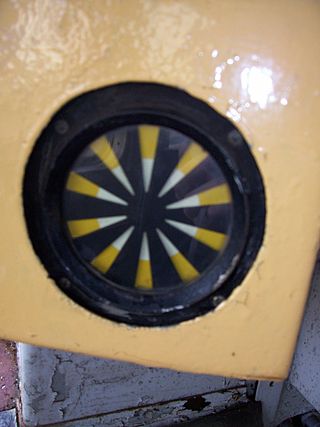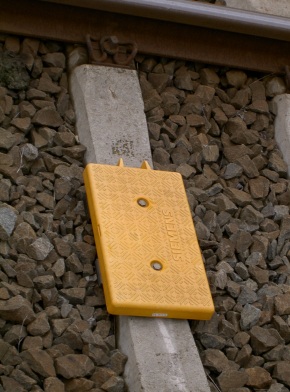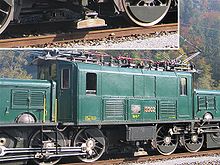The Train Protection & Warning System (TPWS) is a train protection system used throughout the British passenger main-line railway network, and in Victoria, Australia.

A balise is an electronic beacon or transponder placed between the rails of a railway as part of an automatic train protection (ATP) system. The French word balise is used to distinguish these beacons from other kinds of beacons.

Automatic Warning System (AWS) is a railway safety system invented and predominantly used in the United Kingdom. It provides a train driver with an audible indication of whether the next signal they are approaching is clear or at caution. Depending on the upcoming signal state, the AWS will either produce a 'horn' sound, or a 'bell' sound. If the train driver fails to acknowledge a warning indication, an emergency brake application is initiated by the AWS. However if the driver correctly acknowledges the warning indication by pressing an acknowledgement button, then a visual 'sunflower' is displayed to the driver, as a reminder of the warning.

Part of a railway signalling system, a train stop, trip stop or tripcock is a train protection device that automatically stops a train if it attempts to pass a signal when the signal aspect and operating rules prohibit such movement, or if it attempts to pass at an excessive speed.

Automatic train control (ATC) is a general class of train protection systems for railways that involves a speed control mechanism in response to external inputs. For example, a system could effect an emergency brake application if the driver does not react to a signal at danger. ATC systems tend to integrate various cab signalling technologies and they use more granular deceleration patterns in lieu of the rigid stops encountered with the older automatic train stop (ATS) technology. ATC can also be used with automatic train operation (ATO) and is usually considered to be the safety-critical part of a railway system.

The European Train Control System (ETCS) is a train protection system designed to replace the many incompatible systems used by European railways, and railways outside of Europe. ETCS is the signalling and control component of the European Rail Traffic Management System (ERTMS).
The Charfield railway disaster was a fatal train crash which occurred on 13 October 1928 in the village of Charfield in the English county of Gloucestershire. The London, Midland and Scottish Railway (LMS) Leeds to Bristol night mail train failed to stop at the signals protecting the down refuge siding at Charfield railway station. The weather was misty, but there was not a sufficiently thick fog for the signalman at Charfield to employ fog signalmen. A freight train was in the process of being shunted from the down main line to the siding, and another train of empty goods wagons was passing through the station from the Bristol (up) direction.

PZB or Indusi is an intermittent cab signalling system and train protection system used in Germany, Austria, Slovenia, Croatia, Romania, Israel, Serbia, on two lines in Hungary, on the Tyne and Wear Metro in the UK, and formerly on the Trillium Line in Canada.

The Harrow and Wealdstone rail crash was a three-train collision at Harrow and Wealdstone station in Wealdstone, Middlesex during the morning rush hour of 8 October 1952. The crash resulted in 112 deaths and 340 injuries, 88 of these being detained in hospital. It remains the worst peacetime rail crash in British history and the second deadliest overall after the Quintinshill rail disaster of 1915.

The railway signalling system used across the majority of the United Kingdom rail network uses lineside signals to control the movement and speed of trains.
A train protection system is a railway technical installation to ensure safe operation in the event of human error.

A Eurobalise is a specific type of a balise installed between the rails of a railway. Eurobalises are part of the European train control system (ETCS). The balises are pre-programmed and contain information that is read by train antennas. One of their many functions is to allow a train to determine its location.
Transmission balise-locomotive is a train protection system used in Belgium and on Hong Kong's East Rail line.

Advanced Civil Speed Enforcement System (ACSES) is a positive train control cab signaling system developed by Alstom. The system is designed to prevent train-to-train collisions, protect against overspeed, and protect work crews with temporary speed restrictions. The information about permanent and temporary speed restrictions is transmitted to the train by transponders (Balises) lying in the track, coded track circuits and digital radio. It was installed beginning in 2000 on all of Amtrak's Northeast Corridor between Washington and Boston, and has been fully active since December 2015, a few months after the 2015 Philadelphia train derailment which it would have prevented.
The Knowle and Dorridge rail crash was a fatal rail crash that occurred at Dorridge railway station in Warwickshire, England, on 15 August 1963. Three people died in the crash after a signalman's error routed a small freight train into the path of an express passenger train which slowed but could not stop before colliding with it.
Swiss railway signalling describes the railway signalling systems used in Switzerland by the different railway companies. There are two main types of signal, used up to 160 km/h, above which speed cab signalling is required.
The Slough rail accident happened on 16 June 1900 at Slough railway station on the Great Western Main Line when an express train from London Paddington to Falmouth Docks ran through two sets of signals at danger, and collided with a local train heading for Windsor & Eton Central. Five passengers were killed; 35 were seriously injured, and 90 complained of shock or minor injuries
The Berlin S-Bahn Train Control System - Zugbeeinflussungssystem S-Bahn Berlin (ZBS) - is a train protection system based on Eurobalises that is designed for the specific requirements of the S-Bahn Berlin rapid transit rail network. It is able to gradually replace the old system based on train stops with overlap safety.

The train protection system Geschwindigkeitsüberwachung Neigetechnik enables to rise the speed of tilting trains until 30 % above the limits for conventional trains. It is installed on numerous lines in Germany along with the traditional Punktförmige Zugbeeinflussung (PZB) intermittent signalling system.

The ZUB 1xx system is a family of train protection systems produced by Siemens. Its ZUB balises were deployed in the ZUB 121 train protection system in the Swiss railway network, in the ZUB 122 tilting control system in the German railway network, and in the ZUB 123 train protection system in the Danish railway network. Some of these were adapted for other railway lines before the next generation ZUB 2xx family was introduced which is based on Eurobalises - the earlier ZUB balises are not compatible with those.













